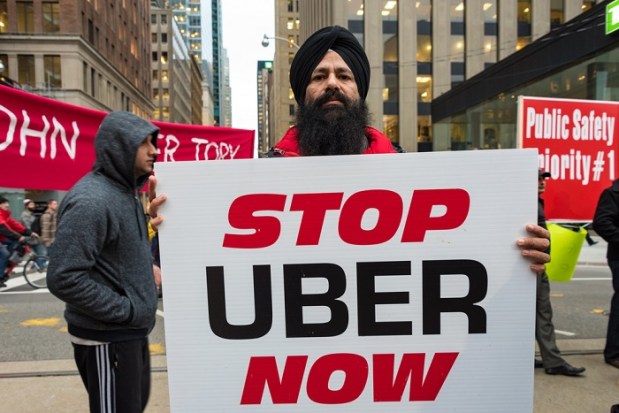When Does Uber Hit The Protest Panic Button?

If there’s one looming battle that the champions of the sharing economy have been putting off, it’s their relationship to the workers that make all the gears run smoothly. As Uber, Amazon and others get into the on-demand delivery game, a surge in traffic is likely to uncover some of the hidden fault lines in the still-growing industry, particularly those between management and labor.
Look no further than the growing number of organized protests Uber is faced with nearly every month now. These demonstrations aren’t what the popular ride-hailing app is used to — cabbies blocking the streets around offices, tailing Uber drivers to scare off fares, etc. — but rather unrest from within. In early January, the company announced that it would be slashing per mile rates based on expected rider increases, claiming all the while that the pricing adjustments would ultimately lead to more fares and higher total wages for drivers. In response, groups of Uber drivers in markets across the country have organized protests against Uber officials directly or indirectly by attempting to deny service to a specific area. The New York Times reported in early February on demonstrations outside the company’s Manhattan headquarters, where hundreds of drivers clogged the streets and pledged to turn their phones off so as not to show up on Uber’s systems.
As disheartening as it may be to the labor advocates in this fight, these run-of-the-mill protests against the owners of the sharing economy’s means of production aren’t likely to give many tech CEOs restless nights. Instead, concentrating their force in the most high-profile of ways, such as during Uber’s crucial partnership with the NFL at Super Bowl 50, could throw a big enough wrench into a service in which the customer experience is everything. The San Francisco Chronicle has the story of the would-be strike that could have taken down Uber’s official pick-up stand at Levi’s Stadium in Santa Clara – organizers spent weeks distributing flyers with demands to other drivers, promoting the hashtag “#UberSuperBowlStrike” and calling for hundreds of drivers to log out of their apps and block an intersection near the stadium so no other drivers could break their vehicular picket line.
While only about 20 cars showed up to caravan down to Levi’s Stadium, the effort to disrupt an event that Uber’s corporate office so closely tied itself to should indicate that the level of unrest surrounding reduced rates — regardless of their long-term profitability — is something Uber can’t ignore away. WTAE Pittsburgh and AustinInno both reported on organized protests in Pennsylvania and Texas, respectfully, that targeted service during the busy Valentine’s Day weekend. Like the Super Bowl protest, these might not handicap Uber’s ability to put any drivers on the road, but they’re proof enough that the price reductions haven engendered some type of long-term distrust between drivers and corporate.
Protests might draw the media headlines, but what if the most harmful effects of Uber’s price reductions are actually being caused by drivers still on the road? An anonymous Uber driver told The Observer that with lower average fares, he has become more selective about who he picks up, to the detriment of customer service. Instead of waiting for a rider to correct a pickup address, he said that he’s more likely to drop the fare and take the $5 cancellation fee from Uber then and there.
“I now do not wait over five minutes for a passenger to show up when I arrive, because I get $5 for a cancel fee rather than driving them three miles to get the same $5,” the unnamed driver told The Observer. “I stopped offering bottled water to my passengers. If the passenger did not put in the correct pickup address I won’t drive unpaid miles to the correct address if they call me, I’ll just collect the cancellation fee.”
So while Uber might not need to be too concerned about the growing number of disgruntled drivers and organized protests around the country, they better take a look at how their pricing practices affect the drivers who do stay on the roads. Because as soon as the average rider thinks there’s a better experience to be had with a ride-hailing service like Lyft or others that pay their drivers more, they might not hesitate to make the jump.
